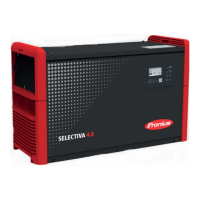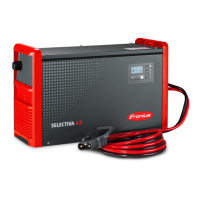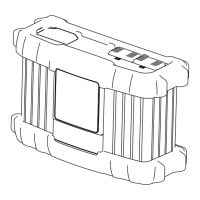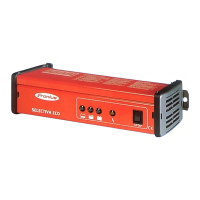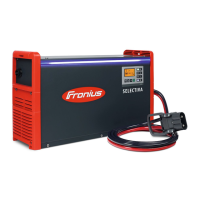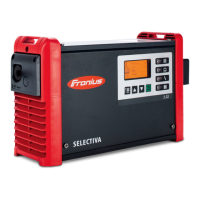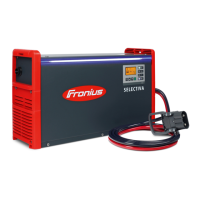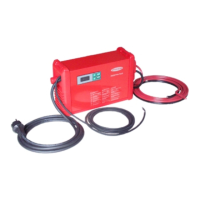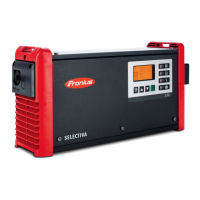Do you have a question about the Fronius Selectiva 4.0 Series and is the answer not in the manual?
kW information relates to housing design, not direct device output.
Lists Selectiva models for the 2 kW power category.
Lists Selectiva models for the 3 kW power category.
Covers general safety, environmental, and grid connection guidelines.
Details risks from electrical currents, battery acid, gases, and explosive vapours.
Guides on battery handling, personal protection, and safe operation.
Covers EMC standards, data protection, maintenance, repair, and operator duties.
Details safety inspections, device markings, disposal, and copyright information.
Defines DANGER, WARNING, CAUTION, and NOTE safety symbols.
Details the intelligent charging technology and robust design.
Specifies intended use and manufacturer liability.
Crucial warnings and requirements for connecting to the power grid.
Safe handling and arrangement of charging leads to prevent hazards.
Explains warning labels on and inside the device and setup regulations.
Details setup regulations, including protection class and orientation.
Identifies key controls and connection ports on the device.
Details the control panel layout and LED status indicators.
Detailed pin assignment for the 2 kW charger's option plug.
Detailed pin assignment for the 3 kW charger's option plug.
Explains the display, Menu, Up/Down, and Pause/Start keys.
Describes the blue (cooled), red (fault), and yellow (charge) indicators.
Explains the yellow (charge) and green (battery charged) indicators.
Guides through initial language, date, time, and cable length settings.
Instructions for setting charging cable length and cross-section.
Details setting battery type, characteristic, and charging time.
Critical warnings about faulty batteries and incorrect charge settings.
Emphasizes cleaning charging plug contacts to prevent damage.
Explains the standard display during charging and battery status indication.
How to pause and restart the charging process using the Pause/Start key.
Procedures for safely stopping charging and disconnecting leads.
Guidance on when and how to disconnect the battery after charging.
Explains Standard, Statistics, History, Configuration, and USB modes.
Describes the default display and charger parameters shown.
How to access and navigate through the device menus.
How statistics mode displays operating statuses and frequencies.
Provides information on stored charging process parameters and symbols.
Details settings for battery charging, additional functions, and general options.
Step-by-step guide to open the configuration menu using a code.
Explains how to set charging time, cells, and characteristics.
Details the "Settings" menu options for charging parameters.
Explains the electrolyte circulation system and its control.
Describes settings like Off, Continuous, Program 1-5, Automatic, and User modes.
Explains automatic adjustment and required sensor connection.
Configuration for overtemperature error and warning messages.
Covers OFF, Delay, Weekday, and Manual equalising charge.
Explains charge start delay and charge end delay parameters.
How to activate the calendar for automatic charging start.
Setting up five different charging start time profiles for each day.
Configuring week and year-based charging schedules.
Using repeat settings and disabling start button for special charges.
Recharging a battery when not needed to extend usage interval.
Explains the DC connection check setting and error code 17.
Configures the blue LED indicator for battery cooling status.
Sets up external control for starting, stopping, and contact detection.
Manages refill reminders and option box settings for 2/3 kW models.
Customizing language, display contrast, brightness, and Ah display.
Configuring time, date, daylight saving, and charging cable parameters.
Settings for USB logging time and resetting device configurations.
Requirements for USB flash drives used with the device.
How to update firmware, download data, and load configurations via USB.
How to download logged data, events, and device configurations.
Explains status codes related to battery faults and general errors.
Lists status codes caused by external factors like grid voltage.
Details status codes specific to battery issues.
Lists status codes indicating problems during the charging process.
Identifies faults in the primary circuit, like sensor or power supply issues.
Lists faults related to the secondary circuit, like temperature or voltage issues.
Details faults within the controller, such as memory or initialization errors.
Covers update failures, communication faults, and incorrect software issues.
General safety notices when connecting optional components.
Specific safety notes for the 3 kW electrolyte circulation option.
Notes on mains voltage tolerance for electrolyte circulation.
Instructions for cleaning the air filter insert for the air pump.
How the external start/stop option prevents sparking and improves safety.
Explains how temperature-controlled charging enhances battery life.
Describes the LED strip as a visual status indicator.
Function of the air filter in dusty environments and warnings for use.
Information on installing wall and floor brackets for secure mounting.
Details the mobile kit for portability and option box for additional information display.
Provides detailed dimensions for fitting plates for 2 kW and 3 kW models.
Allows full device control from a distance up to 30m.
Facilitates easy connection of the Gateway for network communication.
Lists mains voltage, frequency, protection class, EMC class, and dimensions.
Table detailing AC current, power, voltage, and weight for 2 kW models.
Lists mains voltage, frequency, protection class, EMC class, and dimensions for 3 kW models.
Table detailing AC current, power, voltage, and weight for 3 kW models.
kW information relates to housing design, not direct device output.
Lists Selectiva models for the 2 kW power category.
Lists Selectiva models for the 3 kW power category.
Covers general safety, environmental, and grid connection guidelines.
Details risks from electrical currents, battery acid, gases, and explosive vapours.
Guides on battery handling, personal protection, and safe operation.
Covers EMC standards, data protection, maintenance, repair, and operator duties.
Details safety inspections, device markings, disposal, and copyright information.
Defines DANGER, WARNING, CAUTION, and NOTE safety symbols.
Details the intelligent charging technology and robust design.
Specifies intended use and manufacturer liability.
Crucial warnings and requirements for connecting to the power grid.
Safe handling and arrangement of charging leads to prevent hazards.
Explains warning labels on and inside the device and setup regulations.
Details setup regulations, including protection class and orientation.
Identifies key controls and connection ports on the device.
Details the control panel layout and LED status indicators.
Detailed pin assignment for the 2 kW charger's option plug.
Detailed pin assignment for the 3 kW charger's option plug.
Explains the display, Menu, Up/Down, and Pause/Start keys.
Describes the blue (cooled), red (fault), and yellow (charge) indicators.
Explains the yellow (charge) and green (battery charged) indicators.
Guides through initial language, date, time, and cable length settings.
Instructions for setting charging cable length and cross-section.
Details setting battery type, characteristic, and charging time.
Critical warnings about faulty batteries and incorrect charge settings.
Emphasizes cleaning charging plug contacts to prevent damage.
Explains the standard display during charging and battery status indication.
How to pause and restart the charging process using the Pause/Start key.
Procedures for safely stopping charging and disconnecting leads.
Guidance on when and how to disconnect the battery after charging.
Explains Standard, Statistics, History, Configuration, and USB modes.
Describes the default display and charger parameters shown.
How to access and navigate through the device menus.
How statistics mode displays operating statuses and frequencies.
Provides information on stored charging process parameters and symbols.
Details settings for battery charging, additional functions, and general options.
Step-by-step guide to open the configuration menu using a code.
Explains how to set charging time, cells, and characteristics.
Details the "Settings" menu options for charging parameters.
Explains the electrolyte circulation system and its control.
Describes settings like Off, Continuous, Program 1-5, Automatic, and User modes.
Explains automatic adjustment and required sensor connection.
Configuration for overtemperature error and warning messages.
Covers OFF, Delay, Weekday, and Manual equalising charge.
Explains charge start delay and charge end delay parameters.
How to activate the calendar for automatic charging start.
Setting up five different charging start time profiles for each day.
Configuring week and year-based charging schedules.
Using repeat settings and disabling start button for special charges.
Recharging a battery when not needed to extend usage interval.
Explains the DC connection check setting and error code 17.
Configures the blue LED indicator for battery cooling status.
Sets up external control for starting, stopping, and contact detection.
Manages refill reminders and option box settings for 2/3 kW models.
Customizing language, display contrast, brightness, and Ah display.
Configuring time, date, daylight saving, and charging cable parameters.
Settings for USB logging time and resetting device configurations.
Requirements for USB flash drives used with the device.
How to update firmware, download data, and load configurations via USB.
How to download logged data, events, and device configurations.
Explains status codes related to battery faults and general errors.
Lists status codes caused by external factors like grid voltage.
Details status codes specific to battery issues.
Lists status codes indicating problems during the charging process.
Identifies faults in the primary circuit, like sensor or power supply issues.
Lists faults related to the secondary circuit, like temperature or voltage issues.
Details faults within the controller, such as memory or initialization errors.
Covers update failures, communication faults, and incorrect software issues.
General safety notices when connecting optional components.
Specific safety notes for the 3 kW electrolyte circulation option.
Notes on mains voltage tolerance for electrolyte circulation.
Instructions for cleaning the air filter insert for the air pump.
How the external start/stop option prevents sparking and improves safety.
Explains how temperature-controlled charging enhances battery life.
Describes the LED strip as a visual status indicator.
Function of the air filter in dusty environments and warnings for use.
Information on installing wall and floor brackets for secure mounting.
Details the mobile kit for portability and option box for additional information display.
Provides detailed dimensions for fitting plates for 2 kW and 3 kW models.
Allows full device control from a distance up to 30m.
Facilitates easy connection of the Gateway for network communication.
Lists mains voltage, frequency, protection class, EMC class, and dimensions.
Table detailing AC current, power, voltage, and weight for 2 kW models.
Lists mains voltage, frequency, protection class, EMC class, and dimensions for 3 kW models.
Table detailing AC current, power, voltage, and weight for 3 kW models.
| Brand | Fronius |
|---|---|
| Model | Selectiva 4.0 Series |
| Category | Battery Charger |
| Language | English |
